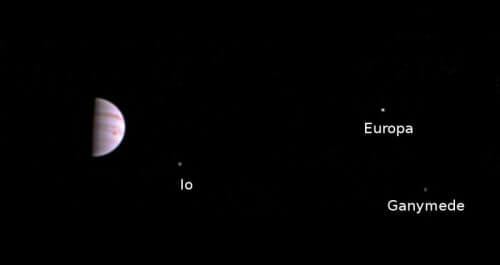In the picture you can see some of the familiar signs of Jupiter, including the Great Red Spot, and three of Jupiter's largest moons - Io, Europa and Callisto

The JunoCam camera on the Juno spacecraft began operating and transmitting data to Earth after the spacecraft's arrival at Jupiter on July 4.
The image, in visible light, was activated six days after the activation of the main engine that brought it into orbit around Jupiter. The first high-resolution image of the gas giant will still have to wait a few more weeks.
The view from JunoCam indicates that the spacecraft survived the passage through Jupiter's extreme radiation environment unscathed and is ready to photograph Jupiter." says Scott Bolton, principal investigator at the Southwest Research Institute in San Antonio. "We can't wait to see the first images of Jupiter's poles."
The image was taken on the morning of July 10 when the spacecraft was 4.3 million kilometers away from Jupiter on its receding leg of the capture orbit that will last 53.5 days. In the picture you can see some of the familiar signs of Jupiter, including the Great Red Spot, and three of Jupiter's largest moons - Io, Europa and Ganymede from left to right in the picture.
"JunoCam will continue to take pictures during the first lap," says Kennedy Hansen, a researcher at the Planetary Science Institute in Tucson, Arizona. "The first high-resolution images will be taken on August 27 when Juno makes its approach to Jupiter."
JunoCam is a color visible light camera designed to take scientific photographs of the poles and cloud tops. As Juno's eyes, it will provide a wide-angle view, which will help provide context for the other devices. JunoCam will also be the camera that will provide the images that will be used by the general public, although the images will also help the scientific team, it is not considered one of the scientific instruments of the mission.
During the research mission, Juno will circle Jupiter 37 times, and will hover at a low altitude above the cloud layer - from a distance of 4,100 km. Her instruments will allow her to look through the cloud cover in order to study Jupiter, and the aurora borealis, and further study the structure of Jupiter, its atmosphere and magnetosphere.

3 תגובות
To Shi Dotan, how far is the spaceship from the earth according to her knowledge
Thanks.
The picture shows Jupiter, Europa and Ganymede (not Callisto). Father for your correction…..